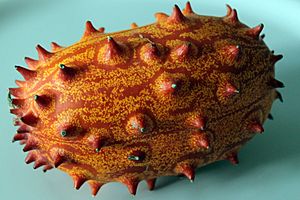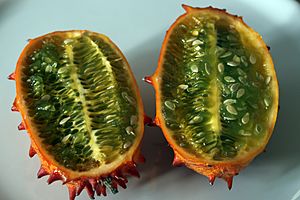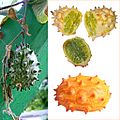Horned melon facts for kids
Quick facts for kids Horned melon |
|
|---|---|
 |
|
| Cucumis metuliferus fruit | |
 |
|
| Scientific classification | |
| Genus: |
Cucumis
|
| Species: |
metuliferus
|
| Nutritional value per 100 g (3.5 oz) | |
|---|---|
| Energy | 183 kJ (44 kcal) |
|
7.56 g
|
|
|
1.26 g
|
|
|
Protein
|
1.78 g
|
| Vitamins | Quantity
%DV†
|
| Vitamin A equiv.
beta-Carotene
|
1%
7 μg
1%
88 μg |
| Thiamine (B1) |
2%
0.025 mg |
| Riboflavin (B2) |
1%
0.015 mg |
| Niacin (B3) |
4%
0.565 mg |
| Pantothenic acid (B5) |
4%
0.183 mg |
| Vitamin B6 |
5%
0.063 mg |
| Folate (B9) |
1%
3 μg |
| Vitamin C |
6%
5.3 mg |
| Minerals | Quantity
%DV†
|
| Calcium |
1%
13 mg |
| Copper |
1%
0.020 mg |
| Iron |
9%
1.13 mg |
| Magnesium |
11%
40 mg |
| Manganese |
2%
0.039 mg |
| Phosphorus |
5%
37 mg |
| Potassium |
4%
123 mg |
| Sodium |
0%
2 mg |
| Zinc |
5%
0.48 mg |
| Other constituents | Quantity |
| Water | 88.97 g |
|
Link to USDA Database entry
|
|
| †Percentages estimated using US recommendations for adults. | |
The Horned Melon is a super cool fruit with a spiky, orange skin and bright green, jelly-like inside! It's also known by many other fun names like African horned cucumber, spiked melon, jelly melon, kiwano, or even cuke-a-saurus.
This unique fruit grows on a vine and belongs to the same plant family as regular cucumbers and melons. It gets its name "horned melon" because of the horn-like spikes all over its skin.
The Horned Melon comes from Southern Africa. You can find it growing naturally in countries like South Africa, Namibia, Botswana, Zambia, Zimbabwe, Mozambique, and Angola.
In Africa, especially in the Kalahari Desert, the Kiwano is a very important traditional food. It's one of the few ways people can get water during the dry season, along with other special desert plants. In northern Zimbabwe, it's called gaka or gakachika. People there often eat it as a snack or in salads. It's usually not just for decoration.
You can eat the fruit at any stage of its ripening. But be careful! If it gets too ripe, it can burst open to release its seeds.
Contents
What Does It Taste Like?
The taste of a Horned Melon is quite interesting! Some people say it tastes like a mix of banana and passionfruit. Others describe it as a blend of banana, cucumber, and lime. Adding a little bit of salt or sugar can make its flavor even better.
The fruit has many seeds, which can make it a bit tricky to eat compared to fruits with fewer seeds. You can also eat the peel, which is packed with healthy things like vitamin C and dietary fiber.
Growing Horned Melons
How Seeds Sprout
For Horned Melon seeds to sprout best, the temperature should be between 20° and 35 °C (68° to 95 °F). If it's too cold, below 12 °C (54 °F), the seeds will sprout very slowly or not at all. The same happens if it's too hot, above 35 °C.
Because of this, it's a good idea to start the seeds indoors in small trays. Once the young plants have two true leaves, they are ready to be moved outside to a garden or field. The best time to plant them outside is in the spring, when the soil and air temperatures are around 15 °C (59 °F).
Plant Health
Pests and Diseases
Horned Melons are pretty tough plants! They can fight off some tiny worms that attack plant roots. Some types of Kiwano are also very good at resisting a plant sickness called Watermelon mosaic virus (WMV-1). However, they can be sensitive to another sickness called Squash mosaic virus (SqMV).
Sometimes, Horned Melons can get a disease called Fusarium wilt. They have also been reported to resist tiny white bugs called Greenhouse whitefly. While they are often resistant to powdery mildew (a type of plant fungus), this disease has sometimes affected Kiwano fields, even in places like Israel.
Images for kids
See also
 In Spanish: Kiwano para niños
In Spanish: Kiwano para niños









